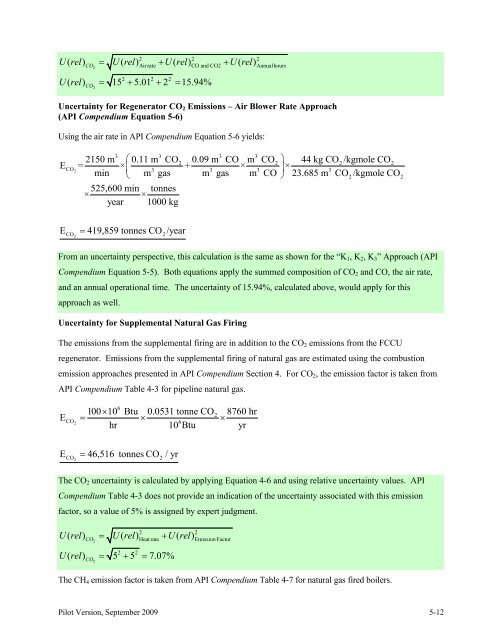addressing uncertainty in oil and natural gas industry greenhouse
addressing uncertainty in oil and natural gas industry greenhouse
addressing uncertainty in oil and natural gas industry greenhouse
Create successful ePaper yourself
Turn your PDF publications into a flip-book with our unique Google optimized e-Paper software.
U( rel) = U( rel) + U( rel) + U( rel)<br />
U rel<br />
CO2<br />
2 2 2<br />
Air rate CO <strong>and</strong> CO2 Annualhours<br />
2 2 2<br />
( )<br />
CO<br />
= 15 + 5.01 + 2 = 15.94%<br />
2<br />
Uncerta<strong>in</strong>ty for Regenerator CO 2 Emissions – Air Blower Rate Approach<br />
(API Compendium Equation 5-6)<br />
Us<strong>in</strong>g the air rate <strong>in</strong> API Compendium Equation 5-6 yields:<br />
E<br />
2150 m<br />
=<br />
⎛0.11 m CO<br />
×<br />
0.09 m CO m CO<br />
+ ×<br />
⎞<br />
×<br />
44 kg CO /kgmole CO<br />
⎝<br />
⎠<br />
525,600 m<strong>in</strong> tonnes<br />
× ×<br />
year 1000 kg<br />
3 3 3<br />
3<br />
2 2 2 2<br />
CO2<br />
⎜ 3 3 3 ⎟<br />
3<br />
m<strong>in</strong> m <strong>gas</strong> m <strong>gas</strong> m CO 23.685 m CO<br />
2/kgmole CO2<br />
E<br />
= 419,859 tonnes CO /year<br />
CO2<br />
2<br />
From an <strong>uncerta<strong>in</strong>ty</strong> perspective, this calculation is the same as shown for the “K 1 , K 2 , K 3 ” Approach (API<br />
Compendium Equation 5-5). Both equations apply the summed composition of CO 2 <strong>and</strong> CO, the air rate,<br />
<strong>and</strong> an annual operational time. The <strong>uncerta<strong>in</strong>ty</strong> of 15.94%, calculated above, would apply for this<br />
approach as well.<br />
Uncerta<strong>in</strong>ty for Supplemental Natural Gas Fir<strong>in</strong>g<br />
The emissions from the supplemental fir<strong>in</strong>g are <strong>in</strong> addition to the CO 2 emissions from the FCCU<br />
regenerator. Emissions from the supplemental fir<strong>in</strong>g of <strong>natural</strong> <strong>gas</strong> are estimated us<strong>in</strong>g the combustion<br />
emission approaches presented <strong>in</strong> API Compendium Section 4. For CO 2 , the emission factor is taken from<br />
API Compendium Table 4-3 for pipel<strong>in</strong>e <strong>natural</strong> <strong>gas</strong>.<br />
E<br />
×<br />
hr 10 Btu yr<br />
6<br />
100 10 Btu 0.0531 tonne CO2<br />
8760 hr<br />
CO<br />
= × ×<br />
2<br />
6<br />
E<br />
= 46,516 tonnes CO / yr<br />
CO2<br />
2<br />
The CO 2 <strong>uncerta<strong>in</strong>ty</strong> is calculated by apply<strong>in</strong>g Equation 4-6 <strong>and</strong> us<strong>in</strong>g relative <strong>uncerta<strong>in</strong>ty</strong> values. API<br />
Compendium Table 4-3 does not provide an <strong>in</strong>dication of the <strong>uncerta<strong>in</strong>ty</strong> associated with this emission<br />
factor, so a value of 5% is assigned by expert judgment.<br />
U( rel) = U( rel) + U( rel)<br />
U rel<br />
CO2<br />
2 2<br />
( )<br />
CO<br />
= 5 + 5 = 7.07%<br />
2<br />
2 2<br />
Heat rate<br />
Emission Factor<br />
The CH 4 emission factor is taken from API Compendium Table 4-7 for <strong>natural</strong> <strong>gas</strong> fired b<strong>oil</strong>ers.<br />
Pilot Version, September 2009 5-12

















